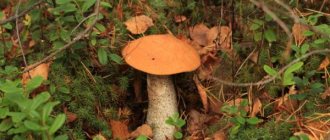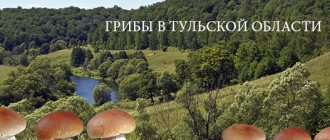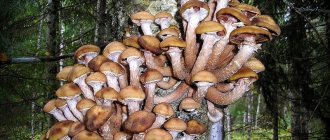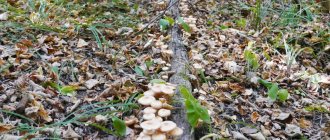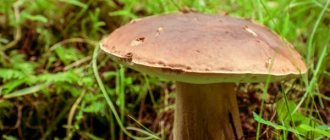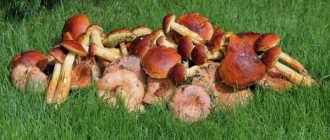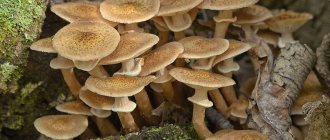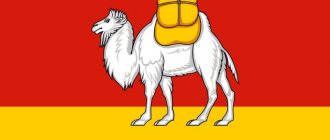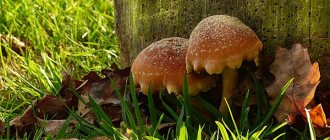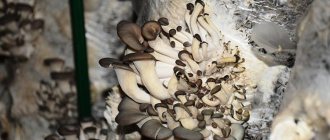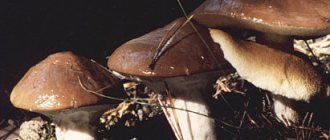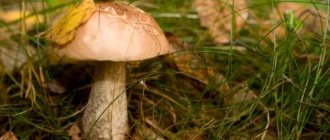Mushrooms
0
1558
Article rating
Kira Stoletova
Mushrooms belong to a special kingdom of living nature - the kingdom of Mushrooms, which has more than 100,000 species, and according to the estimates of a number of mycologists, perhaps 250,000. Most of them live and reproduce on land. Not all of them are suitable for human consumption. Edible mushrooms in the Bryansk region are collected throughout the entire season - early spring, before the onset of persistent cold weather in November.
Mushrooms in the Bryansk region
Mushrooms area
Flag of the Bryansk region
Almost all types of edible and conditionally edible mushrooms grow in these places, but there are also some that are unsuitable for consumption, poisonous, and which cannot be collected. Basically, the mushroom season in the region begins in the spring, when the air warms up to +150C and continues until late autumn.
Expert opinion
Gennady Sergeevich Rylov
A great expert in mycology and an avid mushroom picker. Knows everything about mushrooms, their types and places of growth
The first to appear are the mushrooms growing on trees: auricularia, pecis, May calocybe and other representatives of spring, then species from the summer and autumn groups. There are also names that are characteristic only of this region, which include: hygrophora, milkweed, lion-yellow plutea, pink lacquer, albatrellus sheep, curly sparassis.
general characteristics
Most mushroom species in this region grow on a variety of soil substrates. They participate in the formation of humus and the decomposition of organic matter (mineralization) in the soil. Depending on the species, the processes of forming symbiotic relationships occur next to various representatives of tree species, for example, larches or conifers. The zone of mycorrhiza formation is individual.
A general qualitative characteristic is the presence of vitamins, microelements and other useful substances in the structure of these forest organisms, which well complement the human food basket.
All forest mushrooms are divided according to the degree of edibility and taste categories. Depending on the presence of toxic substances, the degree of edibility is divided into 4 categories (types):
- Category 1: edible;
- Category 2: conditionally edible;
- Category 3: inedible;
- Category 4: poisonous.
Based on their taste, mushrooms are also divided into 4 categories:
The most delicious mushrooms belong to categories 1 and 2.
Category 1 includes mushrooms with excellent taste. It includes russula, champignons, white mushrooms and milk mushrooms. Mushrooms representing this flavor category can be eaten without heat treatment.
Boletus, saffron milk caps, Polish and chanterelles belong to the 2nd taste category . These species make delicious soups, aperitifs and snacks.
The next group - category 3 , consists of less tasty aromatic mushrooms (moss mushrooms, morels, honey mushrooms, etc.) culinary specialists prefer to prepare pates and salads from them. They are considered to have average taste.
Representatives of the 4th taste category have a subtle aroma and preparation requires, in addition to adding spices that will give the dish a more pleasant and piquant taste, careful pre-processing. This category includes mainly all conditionally edible species.
Inedible species
- The satanic mushroom differs from the white one in the presence of black dots on the stem and the color of the pulp.
- The gall mushroom has an unpleasant, bitter taste.
- False puffball has a repulsive odor and tasteless pulp. It is distinguished by the complete absence of a leg.
slawek_magier
grazyna.de
pilzwelten
darkforestfire
How to find saffron mushroom
Saffron milk caps very rarely grow one at a time, much more often in large groups. Having discovered one mushroom, you should carefully examine the surroundings. There will always be several more copies nearby.
It is believed that large and strong saffron milk caps can be found on the northern side of coniferous trees. Additionally, their growth is indicated by companion mushrooms - boletus growing under pine trees.
Advice! If after one or two months, in August-September, you return to the place where a family of saffron milk caps was discovered in July-August, you can again harvest a good harvest of mushrooms.
You need to walk through the forest carefully, looking at your feet. Some mushrooms grow in plain sight, while others can hide in the grass or pine needles. To push it apart, it is convenient to use a long thin straight branch. Small hills under spruce or pine trees, sunny edges are the places that are examined in search of saffron milk caps first.
There are many varieties of these mushrooms. The table provides some recommendations that will help you decide on the choice of place and season for collecting saffron milk caps:
| Variety | Characteristic | Where does it grow | When to collect |
| Ordinary (real, pine, delicacy, pine) | Bright red color and spotted cap. | In young pine forests: under pine trees, along the edges of clearings, clearings, in sunny mossy and grassy places. | Mid-summer – early autumn. |
| Spruce (green) | Smaller than pine saffron milk cap, with fragile flesh and a light-colored cap, which always has a bluish-green coating. | Distributed everywhere in spruce and mixed forests and plantings under spruce trees. | Beginning of August - end of October. |
| Red | Uniform reddish color, the spots on the cap are weakly expressed, the leg has a light powdery coating, its milky juice is almost cherry in color. | It is found in the Urals, Siberia, the European part of Russia, and the mountainous Crimea under Scots pine or Siberian pine. | July – November. |
| Semi-red (pine red) | A distinctive feature is the orange milky juice, which quickly darkens to a dark red hue. The caps of young mushrooms are orange, while those of adults have a greenish tint and a pattern in the form of pronounced concentric circles. | In the temperate zone in pine and mixed pine forests; considered rare in some places. | July – October. |
| Alpine (salmon) | A large cap with a diameter of up to 20 cm is bright orange, the flesh is salmon-colored. | Fir forests from the Western Urals to Northern Europe. | August – October. |
| Finnish (blue) | When cut, it turns blue to a rich shade of indigo. The outer color is brownish or olive with a reddish tint, the plates are bright orange. | On the edges and boundaries of clearings of spruce forests in North-West Russia and Karelia. | August – October. |
| Japanese (fir) | Pale color and mycorrhiza only with whole-leaved fir. | In the Far East, in China, in the north of the Korean Peninsula, in Japan - in forests where whole-leaved fir grows. | September October. |
| Dark | The cap is gray, with a faint orange tint, the plates under the cap are bright orange. When cut, the milky juice changes color from carrot to greenish. | Pine and mixed forests of the northern part of Russia. It is considered a rare mushroom. | August – October. |
| Wine | The color of the fruiting body ranges from dark red to lilac. Young specimens have a rich color, while mature specimens have a light color. | The northern part of the temperate zone in forests with Scots pine. The mushroom is rare. | July – October. |
Important! Rizhik has a mushroom twin. This is a conditionally edible pink trumpet. Its difference lies in the light milky juice and the downward surface of the cap.
A more dangerous double is the inedible amber milkweed. It has a pungent unpleasant odor. It has a longer, without narrowing, leg. The surface of this mushroom has a velvety texture and is colored in brown and pink tones.
Poisonous mushrooms
The following poisonous species are particularly dangerous:
- Pale toadstool is a pale green cap mushroom. On its long leg there is a “skirt”, and from below there is a cup-shaped volva, half going into the ground.
- The red fly agaric is distinguished by a thick, fleshy orange-red cap with numerous flaky yellowish or white warts on a white stalk.
- The sulphur-yellow false honey fungus from the strophariaceae family has a large bell-shaped cap, which straightens as the mushroom grows, and a long stalk.
- A reddish champignon with a whitish-brown cap 5-15 cm in diameter and slightly curved edges becomes yellowish when pressed. The leg is white, hollow, thickened at the base with a two-layer ring, reaching a length of up to 15 cm.
- Poisonous row is characterized by a floury taste and smell. Its color can be light silver, off-white, brown-gray with a blue tint. The leg is dense and mealy.
bo_diesel78
mushroom fixation
Poisonous mushrooms cause hallucinations , vomiting, headaches, convulsions and even death. Therefore, if you doubt the edibility of a mushroom, it is better not to pick it.
Where do saffron mushrooms grow?
Ryzhiki are edible delicious mushrooms belonging to the genus Milky. They have round caps that become funnel-shaped with age. They come in bright yellow, orange, or pinkish colors, but there are other rarely seen color varieties. The stem of the mushroom is proportional to the cap; yellow or orange juice is released from its pulp, which changes color in the air.
Important! For safety reasons, you should not collect any mushrooms of questionable appearance or quality.
Where do saffron milk mushrooms grow in Russia?
Edible red mushrooms are collected throughout most of Russia, but there are few truly mushroom places. In Russian forests, saffron milk caps are especially common in the following regions:
- in the Moscow region - in the forests along the Savelovsky direction, in forests near Torbeevskoye Lake, on the northern side of Gremyachey Falls, near Ashukinskaya station;
- in pine forests of the Voronezh region;
- in the forests of Saratov and Samara regions;
- in Transbaikalia;
- in the vicinity of lakes Shchelkun (Sverdlovsk region) and Allaki (Chelyabinsk region), located along the Chelyabinsk tract;
- in the Ochersky and Elovsky districts of the Perm Territory;
- near the village of Minderla near Krasnoyarsk.
Advice! You can collect saffron milk caps in young pine, spruce and mixed forests throughout Russia.
In which forest do saffron milk caps grow?
These mushrooms grow mainly on sandy soils. A nearby river creates optimal soil and air humidity for them. The most suitable young forests for saffron milk caps are:
- pine;
- spruce;
- cedar;
- fir;
- mixed birch-spruce-fir;
- other mixed forests with an abundance of conifers.
Such mushrooms are rarely found in deciduous forests where there are solitary coniferous trees. They can grow not only in natural conditions, but also in artificial spruce plantings or self-seeding in fields.
Important! In order not to confuse the saffron milk cap with another mushroom, it is enough to lightly scratch its plate. Sweetish orange or red juice will come out of it.
Under what tree do saffron milk caps grow?
Saffron milk caps grow under spruce, fir, pine or cedar up to 5 m high. The peculiarity of these mushrooms is that they form a symbiosis with a coniferous tree. The mycelium penetrates the root of the plant and entangles it. Additionally, thanks to the fungus, the tree receives moisture and microelements and supplies the camelina with carbohydrates and amino acids that are not found in the soil.
Comment! Spruce camelina grows mainly in the forest. Pine - can grow on a single coniferous tree, located even within the city limits, in a park or square.
Its color depends on the type of tree under which the camelina is located, forming mycorrhiza. It can vary from light orange to a rich copper hue. Old mushrooms have a greenish color on their caps.
Where do saffron milk caps grow?
Experienced mushroom pickers know that they should look for saffron milk caps in small forests. A dense thicket is not suitable for them because there is not enough light in it. Places where red-haired representatives are often found:
- young coniferous plantings in fields;
- forest edges and clearings;
- young forest clearings.
Comment! Low forest is an area where low forest grows.
You can often collect a lot of saffron milk caps on hillocks and small hills overgrown with short grass or moss. Dew also creates good conditions for the development of mycelium.
Typical places for these mushrooms are:
- open and illuminated meadows;
- overgrown fields with small shrubs and spruce trees;
- verges of clearings and forest roads;
- long ditches, well lit by the sun.
Advice! You should not look for saffron mushrooms in shady places with waterlogged soil.
Mushroom places
Famous mushroom places in the Bryansk region include:
- The suburbs of Bryansk, replete with boletus, chanterelles, honey mushrooms, russula and milk mushrooms.
- Forests near the villages: Temenichi, Domashovo, Kokino, Chaikovichi village with all types of edible mushrooms.
- Navlinsky district with boletus, saffron milk caps and honey mushrooms.
- Pine forests near the town of Seltso with boletus and saffron milk caps.
- Pogarsky, Gatchina and Karachevsky districts, rich in honey mushrooms.
- Places near the village of Suponevo, famous for their large harvests of russula.
How to properly collect saffron milk caps
To collect these particular mushrooms, you should, without wasting effort on other varieties, purposefully look for those places where saffron milk caps grow or can grow. When a suitable area is found, it is carefully inspected, step by step, pushing apart the grass and pine needles with a long stick.
Advice! The most valuable are saffron milk caps with small diameters. They have dense and tasty pulp and are not damaged by worms and insects, unlike more mature specimens.
Mushrooms are collected by saffron milk caps in any convenient way. They can be cut with a knife, twisted or torn off. This, contrary to popular belief, does not affect mycelium and mycorrhiza: in order for the fungus to stop growing in its usual place, it is necessary to cut down the tree and uproot its roots.
The video clearly shows how you can organize the collection of saffron milk caps in the forest:
What is collected in spring, summer and autumn
| Collection month. | Name of the mushroom. |
| April June. | Orange beetroot, May calocybe, auricularia, morels, stitches. |
| May. | Raincoat. |
| June-September. | Boletus, boletus, boletus, moss mushroom, boletus. |
| June-October. | Volnushki, russula, milk mushrooms. |
| Aug. Sept. | Polish mushrooms, saffron milk caps. |
| September-November. | Autumn honey mushrooms, champignons. |
Thus, the mushroom picking season lasts from early spring until the onset of persistent cold in November.
At what temperature do saffron milk caps grow?
Saffron milk caps grow in the summer - from July to September. In warm weather they begin to appear as early as June. The last mushroom can be found in the first ten days of November. After autumn frosts they disappear.
These are heat- and sun-loving mushrooms. They begin to actively develop when there is sufficient sunlight and at a temperature of at least 10 0C. They grow well under certain conditions:
- temperature 15 - 27 0C;
- relative air humidity 50 - 60%.
Important! In hot and dry summers, these mushrooms may not bear fruit.
